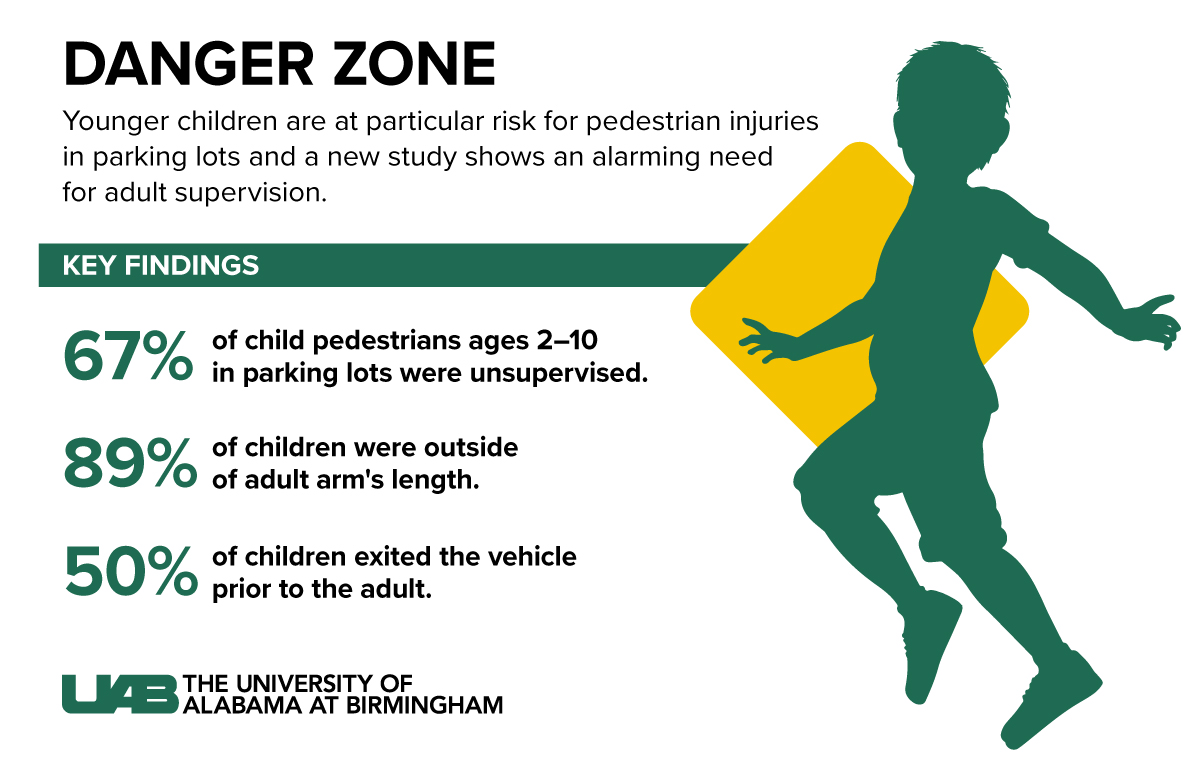Children can be seen running across parking lots without adult supervision every day, and the consequences can be fatal.
 In the United States, an estimated 5,000 injuries and 205 fatalities of children age 14 years and younger occur from collisions with vehicles in non-traffic locations, like parking lots, driveways and private property, according to the National Highway Traffic Safety Administration’s 2007 report.
In the United States, an estimated 5,000 injuries and 205 fatalities of children age 14 years and younger occur from collisions with vehicles in non-traffic locations, like parking lots, driveways and private property, according to the National Highway Traffic Safety Administration’s 2007 report.
A new study from the University of Alabama at Birmingham shows an alarming need for adult supervision in parking lots, with 67 percent of children observed not having supervision at some point between the vehicle’s parking and the child’s entering the building.
“Children are unpredictable,” said David Schwebel, Ph.D., associate dean for research in the UAB College of Arts and Sciences. “The safety risks in parking lots are already dangerous. We observed that parents pay less attention to their children in these parking lots, even further elevating the risk.”
The study, published in the Journal of Safety Research, observed 124 children ages 2-10 and their adult supervisors as they crossed a parking lot from their parked vehicle into a community recreation center. While a majority of children are unsupervised, the study also showed that 88.9 percent of children in a parking lot are outside of an adult’s arm reach. And, more than half of the children observed exited the vehicle prior to the adult.
Investigators believe that the perception of risk diminishes in well-known, familiar locations, because adults and children feel “safe.” Jenni Rouse, a doctoral student in the UAB Department of Psychology, explains that adults and children may not see risks in parking lots because vehicles are moving more slowly, injury rates are perceived as lower in this environment, there is an eagerness to get to where they are going. However, various distractions like cellphones are present, and there is a transfer of responsibility for creating a safe environment from the pedestrian to the driver.
“As adult supervisors, we are responsible for teaching children basic pedestrian safety practices and leading by example,” Rouse said. “Adult supervision of children in a parking lot setting is apparently poor, creating significant safety risks. By addressing the concerns of pedestrian safety with children in parking lots, we can help cut down on the number of injuries presented in emergency departments and hopefully save a child’s life.”
 Adult supervision in parking lots could reduce risk of injury.Targets for intervention
Adult supervision in parking lots could reduce risk of injury.Targets for intervention
As a public health concern, there are several targets for intervention that could decrease the risk for child injury or death in parking lots, including improved adult supervision, safer child behaviors, safer driving behavior and alteration of parking lot environments.
“We must alter the perceived risk seen by adults to change perception and implement new interventions,” Rouse said. “Behavioral changes for adults and setting boundaries for children could improve the risks found in parking lots, alongside environmental design of parking lots.”
Rouse recommends adult supervisors implement injury prevention strategies, including:
- Holding a child’s hand in parking lots
- Making sure children remain in the car until an adult opens the door
- Exiting the car from the passenger side when being dropped off near a building to avoid cars passing on the driver side
- Teaching basic pedestrian safety practices, like looking both ways for traffic before crossing the parking lot
- Making children aware of traffic and the dangers associated with moving vehicles
- Using sidewalks when available
- Reducing distractions as children are guided through a parking lot, including cellphones and conversations with others
Teach safety practices early
Caretakers should begin teaching their children basic safety practices at a young age. These practices include:
- Checking for moving vehicles by looking both ways before crossing the street
- Watching for vehicles that are backing up
- Walking in parking lots and avoiding horseplay
For a driver in a parking lot, attention should be even more focused and attuned to those in the parking lot. Rouse recommends that drivers slow down and eliminate any distractions as they navigate parking lots. Using backup cameras and paying attention to surroundings can make a significant impact in the reduction of death and injuries in parking lots.
Environmental factors that can help reduce risk start with alterations in a parking lot. Reducing speeds allows for greater reaction time for attentive drivers to respond to reckless child behavior. This also reduces the intensity of impact should an incident occur. Additional alterations include posting and enforcing speed limits in parking lots, adding speed bumps to slow traffic, and adding sidewalks or pedestrian-only areas.
“Overall adults should be more attentive when they are in a parking lot, whether they are driving or walking,” Rouse said. “It is our responsibility to educate adults and children on the dangers and interventions to reduce risks.”
